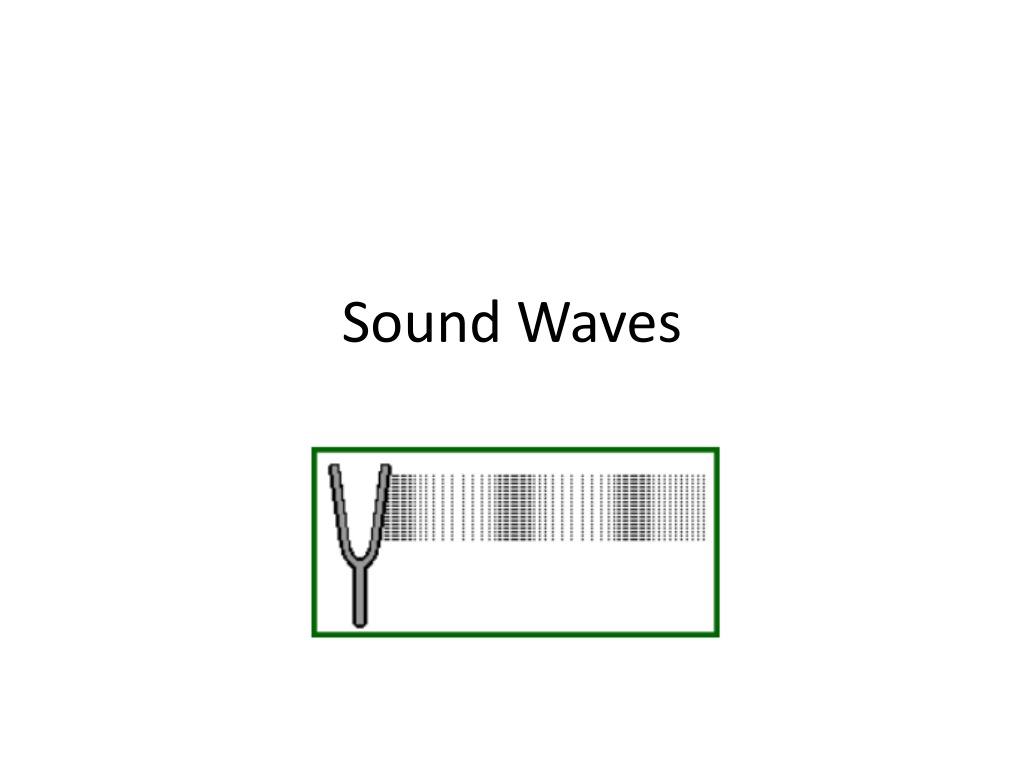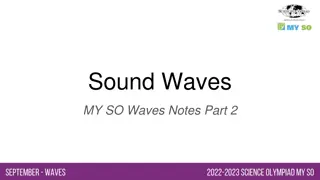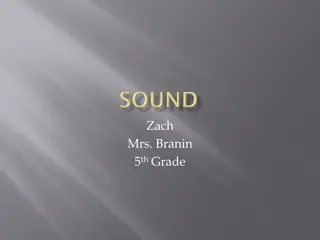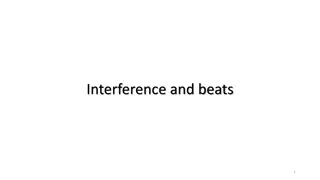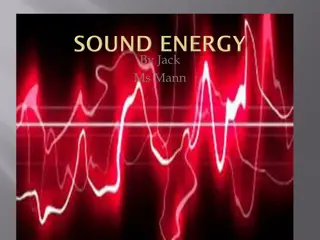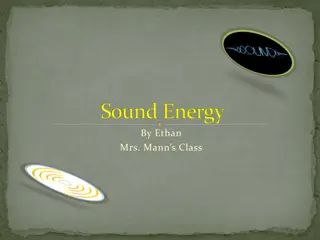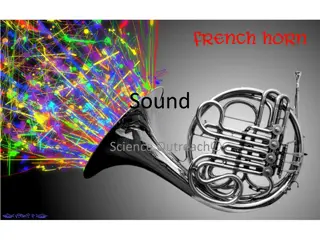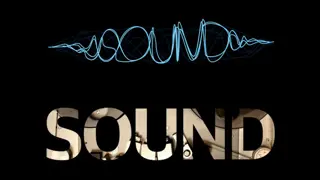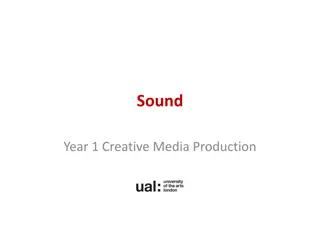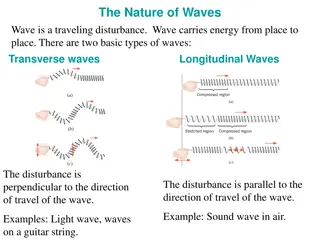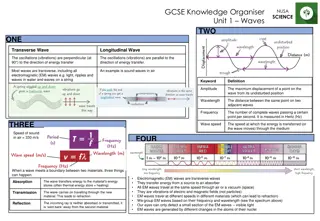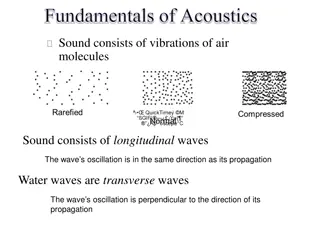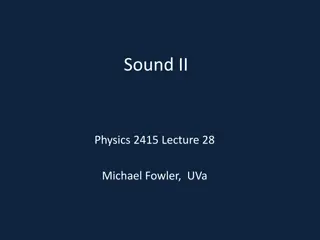Exploring Essential Questions About Sound Waves
Delve into the fundamental aspects of sound waves through essential questions, observations of sound wave behavior, key facts, and measurements. Understand the nature of sound waves, including frequency, amplitude, speed of sound, and perception attributes like pitch and intensity level. Discover how to observe and experiment with sound waves to enhance your understanding of this fascinating phenomenon.
Download Presentation

Please find below an Image/Link to download the presentation.
The content on the website is provided AS IS for your information and personal use only. It may not be sold, licensed, or shared on other websites without obtaining consent from the author. Download presentation by click this link. If you encounter any issues during the download, it is possible that the publisher has removed the file from their server.
E N D
Presentation Transcript
What are some (essential) questions about sound?
Essential Questions: What kind of wave is a sound wave? What are the facts and measurements to know? Which measurement affects if a sound is high or low? Which measurement affects if a sound is loud or quiet? What ranges of sounds can humans hear? Other animals? How fast does sound travel? Which wave phenomena does sound exhibit? Which are most obvious with sound? If a tree falls in the forest, and no one is there to hear it, does it make a sound?
Observing Sound Waves: On PhET, play with Wave Interference, Waves, Select the speaker symbol 1. What does changing the frequency do to other wave measurements? (Change f, what do you see what would you HEAR?) 2. What does changing the amplitude do to other wave measurements? 3. Now, adjust each of the items you can control. With your partner, discuss what each change teaches you.
Observing Sound Waves: What did you learn? Which change affected the speed of sound?
Facts and Measurements Sound is a longitudinal mechanical wave with: compression: region where the medium is squeezed together rarefaction: region where the medium is pulled apart Wavelength: distance from one compression to the next Pressure Amplitude: difference between the relaxed pressure in the medium and the max or min pressure https://www.youtube.com/watch?v=pWekXMZJ2 zM
What does it sound like? The perception of the frequency is the PITCH (simple!) The perception of the (pressure) amplitude is the INTENSITY LEVEL (complicated!) Intensity = energy / (duration * area) I = power / area = (10dB) log (I/Io) (where = INTENSITY LEVEL measured in dB) Hearing test?
The Speed of Sound What affects it? How could you measure it? When can you use it? (when is it relevant?)
Assignment PCR Sound Lessons 2c,d Quest Sound #1-11
Phenomena Skim PCR Sound Lesson 3 Identify one topic you want to learn about Re-read that page well enough to have one take-away that you can describe to a friend or parent
Which Wave Phenomena ALL! Reflection (echo) Interference (beats, resonance) Doppler effect (Chipmunks to Barry White) http://www.youtube.com/watch?v=dC4Lp7k4zrI Refraction (yelling across a pond ) Diffraction (yelling through a megaphone) For further support, consult Lesson 3 PCR Sound
Resonance on a Guitar String When the fundamental frequency is played on a guitar sting, it generates a sound with a frequency of 256 Hz. If the string is 61cm long, determine: a) The speed of the waves on the string b) The frequency of the second harmonic (Hint: draw the string in each harmonic)
Lesson 4&5: Resonance and Standing Waves VOCABULARY TO UNDERSTAND: Natural Frequency Standing Wave Patterns Forced Vibrations Resonance Strings (and standing wave patterns) Open End Air Columns Closed End Air Columns (will be used in lab)
Resonance in Closed End Air Column (pipe) Draw the next two harmonics for standing waves in a closed end pipe. Then, write the three equations that relate the length of the pipe (call it L) to the length of the wave (which you should know we call )
Generate the lowest frequency standing wave pattern in a closed end pipe, then take appropriate measurements and perform appropriate computations to determine the speed of sound in the air. Repeat for three other frequency sounds.
Generate the lowest frequency standing wave pattern in a closed end pipe, then take appropriate measurements and perform appropriate computations to determine the speed of sound in the air. Repeat for three other frequency sounds. State the objective Draw the wave pattern (of the first harmonic in a closed end pipe) Label the length of the pipe (distance between ends) Write the formula relating L to . Present measurements and computed values in a table Show formulas, and sample calculations (with measurements plugged in) for one of the frequencies, backward and forward Average results and state in a concluding sentence. Also, answer: Does the speed of sound depend on the frequency of the sound? Explain.
Procedure: Select a tuning fork. Note the frequency. Using an approximate speed of 340 m/s, compute the pipe length needed for first harmonic resonance to occur. Get a pipe that is a little (about 5cm) longer Make resonance happen, measure pipe length. Taping a ruler to the side of the pipe is helpful! Compute experimental speed of sound.
Report Each student selects one frequency of those your group used (different from the other members). Write a word problem that states all the knowns (measured values). Draw a pic of the standing pressure wave in the pipe. Show length of pipe, and equation relating L to Show calculation of speed of sound from measured pipe length.
Review Problem A student uses a 440Hz tuning fork to make resonance occur at the fundamental frequency in a pipe. To make this occur, the length of the pipe must be adjusted to 19.15cm. a) Determine the speed of sound. b) Compute the length of pipe needed to make resonance at the first harmonic using a 284Hz tuning fork, assuming the speed of sound is the same.
Challenge Assignment Describe how you can use a drum, and a drummer that can maintain a uniform beat, and a tape measure to determine the speed of sound.
